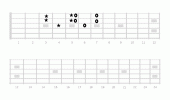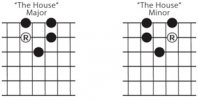Elio
Student Of The Blues
I am usually successful at figuring this stuff out with some perseverance, but I am scratching my head over this one. Solo 5 from 5EBS is a moderate tempo blues in E. Griff uses the minor house pattern at the top of box 2 beginning on the 3rd fret for the minor sound (annotated with stars on my diagram) . That makes perfect sense, since E is the relative minor of G, and box 2 for G starts with it's root on the 3rd fret. To left would be the major house pattern of box 2 for E starting box 2 on E (which is the open string) for essentially 1/2 of the major house pattern -- the other half being the open strings.
However, @Griff is using also another major house pattern starting on the 5th fret and right-facing (noted with circles on my diagram). If that is part of box 2, it would be starting on the root note of A on the 5th fret. Where is this one coming from? I know I'm missing something incredibly obvious here but am just not seeing it. What am I missing?

However, @Griff is using also another major house pattern starting on the 5th fret and right-facing (noted with circles on my diagram). If that is part of box 2, it would be starting on the root note of A on the 5th fret. Where is this one coming from? I know I'm missing something incredibly obvious here but am just not seeing it. What am I missing?


Last edited:


